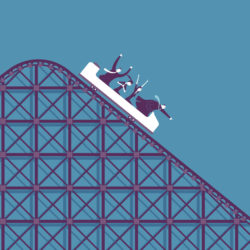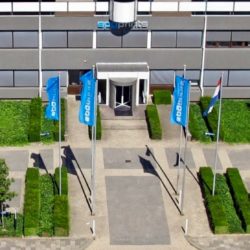Millions spent on supply chain technology fail to deliver

Companies are spending millions of euros on new technologies, but are seeing little to no improvement in their supply chain performance in return. During a recent Webinar Wednesday, Peter Schram from Breakthrough Advisory suggested that companies should take a step back to think about their current status and the next steps as the basis for identifying which technologies are interesting for them. “The question is, what do you want to achieve – digital optimization or digital transformation?” he said.
By Marcel te Lindert
According to a survey by Harvard Business Review, only 28% would describe their company as digitally mature. Peter Schram was not surprised by this low figure. “If you believe all the reports about digital transformation, you’d expect the maturity to be high. But the companies I speak to as a consultant often rate themselves no higher than 1 or 2 on a scale of 1 to 5,” he stated.
Schram has had an impressive career at companies such as DAF and Signify as well as at consultancy firms such as Accenture and IG&H, and he most recently worked as an analyst at Gartner before setting up his own consultancy a year ago. “According to the Harvard Business Review survey, 68% of companies want to put more effort into modernizing their supply chain, but I see many companies struggling with that. There’s a big gap between what’s digitally possible and where companies currently stand.”
The value of technologies
Schram highlighted numerous reasons for embarking on the digitalization journey. The first is simple: the rapidly expanding technological possibilities, such as the use of artificial intelligence to enable lights-out planning or the use of the Internet of Things to create an always-online supply chain. “There number of reasons to deploy these technologies has grown further in recent years. Think of the shortages of materials, labour and resources, or the rapidly changing demand patterns. Before COVID-19, the world was relatively stable, but those days are over. Complexity has increased dramatically.”
Technology can help, but which technology should you choose? Schram referred to Gartner’s hype cycle, which shows which technologies are just a hype and which ones actually deliver value. “Technologies are evolving so fast that we can hardly keep up. Use the hype cycles to learn which technologies are on the market and which ones are interesting for you.”
Virtually no improvement in KPIs
Despite some fantastic technological possibilities, businesses are not managing to make optimal use of them according to Schram. He backed this up with research findings from Gartner and Supply Chain Insights. They show that 30% of companies are mature in the area of tactical planning – e.g. sales & operations planning or integrated business planning – and 10% are mature in strategic planning, i.e. supply chain network design. “But if you look at the KPIs, only 5% of companies have succeeded in improving their performance over the past decade. And that figure relates to performance before the COVID-19 outbreak, and things certainly haven’t improved since then.”
By ‘performance’, Schram meant results in terms of service levels, inventories and costs. “There has been very little improvement in the inventory turnover rate; in fact, it has declined over the past two and a half years because of all the disruptions. Hundreds of millions of euros have been invested in supply chain software, but with very disappointing results. That’s not because of the technology, but because of how it is deployed.”
Short-term focus
So the problem isn’t due to a lack of digital ambitions, but rather due to the plans that are made to realize those ambitions and the ability to execute those plans. “As many as 85% of companies want to have a digital supply chain in place within five years. But companies’ roadmaps often only have a three-year horizon. And all the disruptions of the past few years have only intensified the short-term focus.”
Schram expressed his shock at the fact that less than a quarter of all companies are able to implement an ERP system successfully. “Apparently, we’re not very good at implementing technology! And another question this figure raises: how much time and money should we continue to spend on expensive and complex ERP projects? Perhaps we’d be better off focusing on deploying new technologies that deliver more impact.”
Optimization versus transformation
Schram’s key message was that companies need to prepare better by first thinking about what they want to achieve. Many companies confuse digital optimization with digital transformation, he said. As an example of digital optimization he mentioned the Amazon Go store, where consumers can shop without physically having to pay at a checkout. Instead, smart technology registers what they take off the shelves and the amount is debited automatically. “That’s a great concept which leads to better customer service and higher productivity. It also provides Amazon with a wealth of data for analytical purposes. But it’s not a new business model, so it’s not a digital transformation.”
As an example of digital transformation, he discussed home delivery. Companies that enable consumers to use an app to order groceries for home delivery have introduced a new value proposition that can help them to attract new customers. This could even be linked to a new revenue model, such as a subscription. “This is indeed a new business model, and it also has a major impact on the supply chain. So the question is, what do you want to achieve – digital optimization or digital transformation?” he stated.
Carefully considered choices
A different business model also requires a different approach to planning, and new technologies offer unprecedented opportunities in that area. Schram advised companies to make carefully considered choices. “As I said, in terms of maturity many companies are at level 1 or 2 on a scale of 1 to 5. When I talk to them, they say they are using artificial intelligence or machine learning to improve their demand planning. But why? It’s a good idea to experiment with new technologies, but you need to know exactly what you want to use them for.”
New technologies can help to reduce costs because they allow planners to create a schedule faster, for example. They can also be used to improve the quality of decisions or to plan things that were impossible to plan in the past. Schram: “First, determine where you currently stand in terms of maturity and which steps you need to take to improve it. It’s fine to experiment with new technologies, but remember to focus on those steps.”










